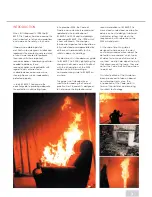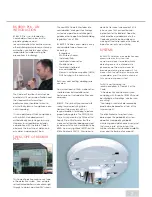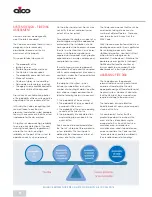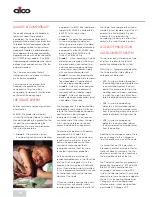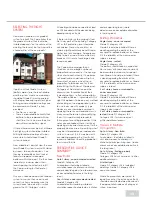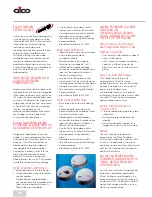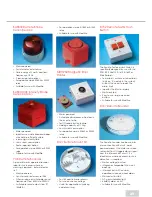
operation, testing, maintenance, false
alarms, escape plans and siting.
TESTING AND MAINTENANCE
Regular routine testing and maintenance
is very important and should be
considered at the design stage.
The Code states that the user has a
responsibility for routinely testing the
system and should be supplied with
simple instructions on how to do this.
All smoke alarm systems should be tested
at least weekly using the integral test
button. Remote test and false alarm
control switches can be used to avoid
the need for the user to reach up to the
alarms. Systems should also be checked
if the occupier has been away or the
power has failed.
In Grade D to F applications, smoke
alarms should be cleaned periodically in
accordance with manufacturers’
recommendations. Where experience
shows that excessive levels of dust are
compromising the effectiveness of the
system, more frequent cleaning and
servicing may be required.
NEGLIGENCE
The exact question of negligence and
liability falls outside the scope of the
standard. It is up to the courts to judge
these issues.
From some considered opinion covering
the area of legal liability we quote
below extracts from an article written on
behalf of the National Housing and
Town Planning Council (NHTPC) by
Martin Daley, to whom we are grateful
for granting us permission to quote from
his work.
According to Daley, the NHTPC has
been fortunate in having sight of
independent research on smoke alarm
liability by Dr Anne Everton. The
following ten situations, based on Dr
Everton’s research, should, says Daley,
‘be avoided at all costs’:
1
Where the smoke alarm is defective
in design
17
provisions might have previously
technically precluded the use of wireless
systems and overcomes this by pointing
out that issues relating to power supplies,
fault monitoring and integrity and
performance may not be the same for
hard wired and radio linked systems.
Special recommendations are also
given to their use in HMOs.
WIRING OF MAINS
POWERED SMOKE AND
HEAT ALARMS
When installing, any cable may be
used which is suitable for domestic
mains wiring, provided it is in
accordance with the relevant parts of
BS 7671.
• There is no requirement for fire
resistant cable and the use of red-
sheathed cable is not required
when installing Grade D, E and F
systems
• 6243Y mains cable is recommended
using the third core for the
interconnect circuit. The earth wire
must not be used for the
interconnect circuit. The maximum
recommended cable run is 250
metres, with 1mm
2
or 1.5mm
2
cable
Amendment No 2 to BS 7671: 2001
allows 'harmonised' cable colours to
be used for installations after 31st
March 2004 (they must be used for
installations commencing after 31st
March 2006). The NICEIC
recommends that 6243Y cable with
the following colours should be used
for smoke alarm systems.
Live -
Brown
Neutral -
Grey
(oversleeve
blue at terminations)
Interconnect -
Black
Great care should be exercised in
ensuring correct identification of the
wiring connections as an
interconnected smoke/heat alarm
system will suffer irreparable damage if
the live and neutral connections are
reversed, or if a 240V phase conductor
is connected to the interconnect
terminal.
• Connect to an independent circuit
at the distribution board if the alarm
does not have a standby supply -
Grade E
• RCD Protection is generally not
required, but if used it should be
dedicated only to the smoke alarm
circuit or be independent of circuits
supplying sockets or portable
equipment
• Smoke alarms should not be
installed in new or renovated
buildings until all work is completed
(including floor coverings) and the
building has been fully cleaned,
unless using an Easi-fit style alarm.
Excessive dust and debris from
building work can contaminate the
smoke chambers and cause false
alarms. It will also invalidate the
guarantee. If alarms must be
installed before work is finished,
either use an ‘Easi-fit’ alarm or
ensure that the alarm is completely
covered, particularly around the
edges, with the dust cover that is
supplied with each of our smoke
alarms
Where appropriate, cable penetrations
should be fire-stopped. If there is any
danger of impact damage, abrasion
or rodent attack, appropriate
protection should be fitted.
A convenient and reliable alternative
to hard wired interconnection is now
readily available in the form of
RadioLINK from Aico (see page 22).
CERTIFICATION AND
PAPERWORK
The installer should certify that the
installation conforms to BS 5839: Pt.6 for
the correct Category and Grade of
system. If any variations have been
agreed to, these should be duly noted.
The Code provides a model certificate
for installers to complete.
Suppliers of the equipment should
provide the occupier of the dwelling
with clear and readily understood
information on the system and its use.
All alarms should come complete with
user instructions, designed to be easily
understood, covering such topics as

